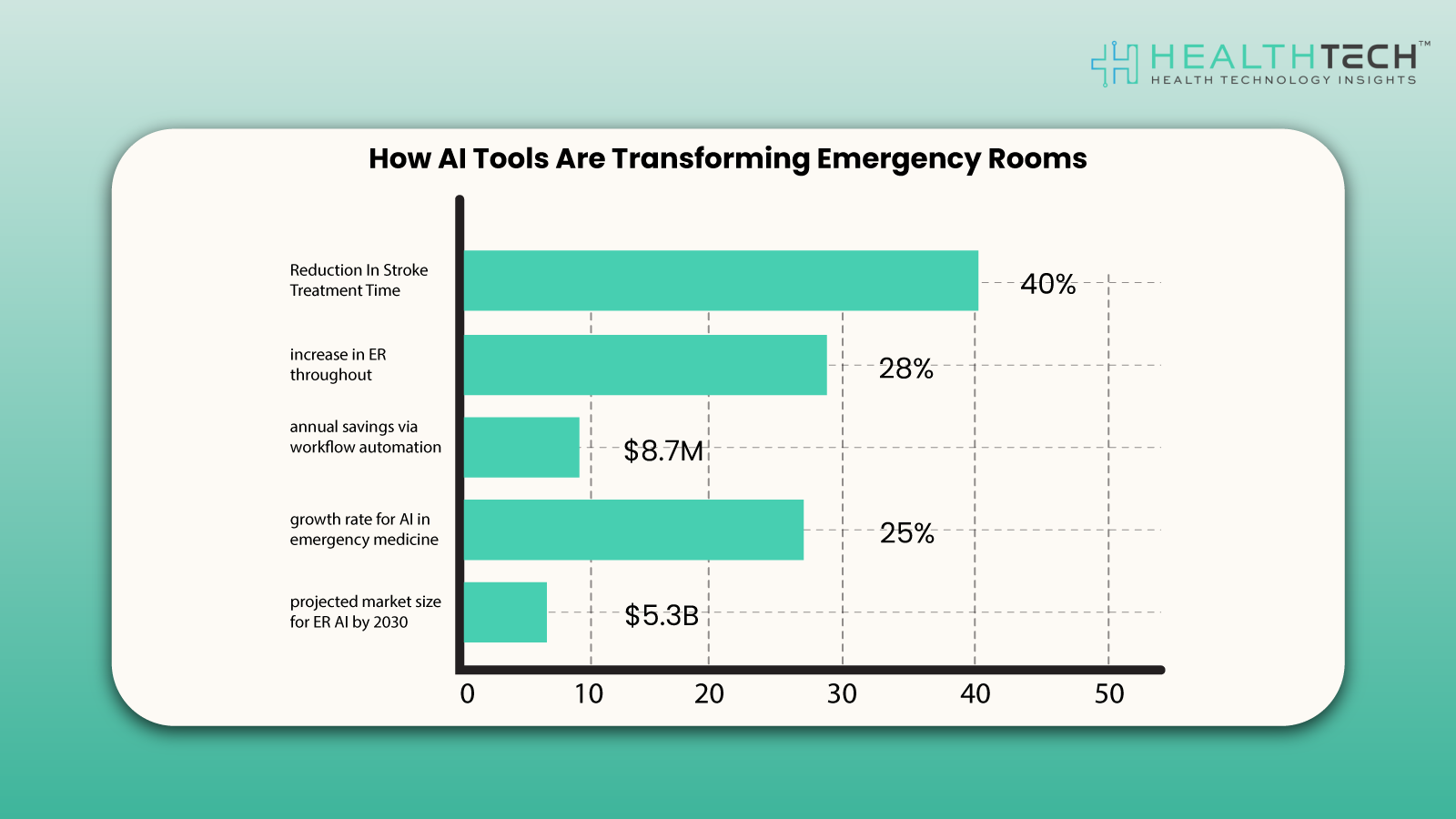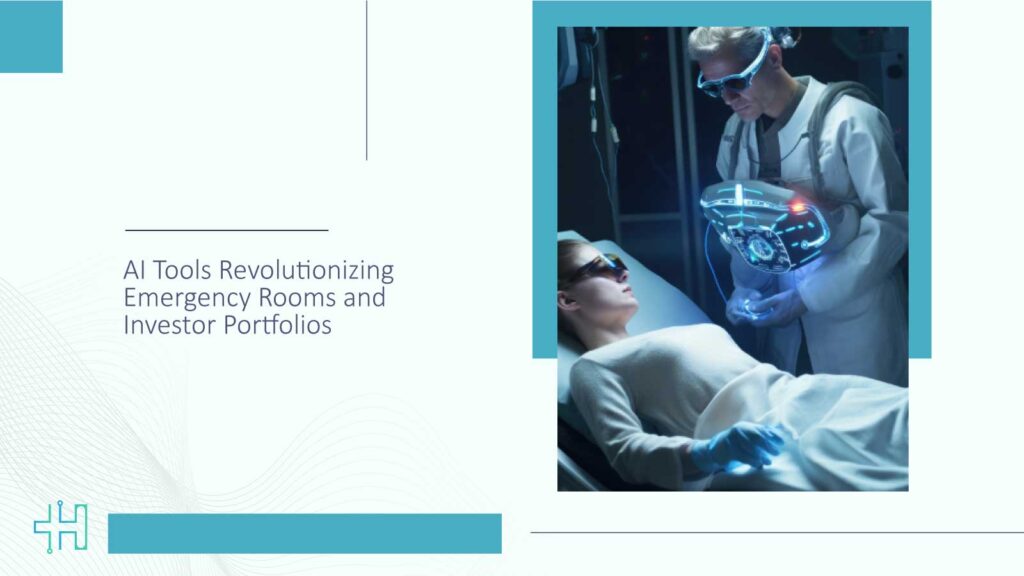Across the U.S., emergency rooms are being quietly reshaped by smart technology. But this shift isn’t just about the tech. It’s about people, patients getting faster care, clinicians making decisions with greater clarity, and investors realizing this might just be one of the smartest bets in healthcare right now.
This is the story of AI tools revolutionizing emergency rooms and investor portfolios, and why the same tools that help doctors save lives are helping investors grow theirs.
In this article, we’ll explore how AI tools are revolutionizing emergency rooms and investor portfolios:
- Helping emergency clinicians detect life-threatening conditions in minutes, sometimes seconds.
- Slashing wait times, reducing medication errors, and boosting diagnostic accuracy.
- Attracting billions in healthtech investments with proven clinical and financial ROI.
- Powering real-world success stories in hospitals like Mount Sinai, BayCare, and Cedars-Sinai.
- Reframing how strategic investors, VCs, and M&A players are placing their bets in healthcare AI.
Whether you’re leading innovation at a healthcare system, managing an investment portfolio, or simply keeping tabs on how technology is improving human outcomes, this is a story worth following. Because the same tools that help doctors move faster are helping markets grow smarter.
Let’s take a closer look at what this means for the future of care and capital.
In Emergency Rooms, Every Second Counts

Let’s start in Florida. At BayCare Health System, emergency teams started using an AI-driven triage assistant called HealthMap Navigator. It doesn’t wait for a doctor to ask the right questions, but starts pulling together data, symptoms, wearables, and electronic records within minutes of the patient walking in.
It doesn’t just rank patients based on urgency, but recommends tests based on risk factors that most humans might miss under pressure. And the payoff? ER wait times are down by nearly a third, according to Harvard Business Review. That means more patients seen, more lives stabilized, and less chaos.
“Having AI in triage is like having a really smart resident who never gets tired,” said one attending ER physician at BayCare. “It doesn’t replace us. It helps us focus.”
But AI’s job doesn’t end at the front desk. In radiology suites, it’s working behind the scenes to spot the stuff that even experienced eyes can miss. Think of tools like Aidoc, Viz.ai, and Qure.ai. They’re now helping ER doctors detect strokes, brain bleeds, and clots with pinpoint accuracy, often in under two minutes.
And it doesn’t stop there. At Johns Hopkins, pharmacists now rely on predictive AI to prevent dangerous medication errors in high-pressure ER environments. It’s quietly scanning for drug interactions and dosage risks in real time. Thanks to this digital safety net, adverse drug events have dropped significantly, especially with high-risk prescriptions like anticoagulants and opioids.
What’s striking here isn’t that AI is flashy. It’s that it’s dependable. It sits in the background, constantly learning, surfacing what matters, and freeing up human experts to do what they do best: care.
And all this is making some very smart investors pay attention.
Wall Street’s Watching the ER
You might not think of ER tech as a hot investment space, but the numbers are telling a different story. The market for AI in emergency medicine is projected to cross $5.3 billion by 2030, growing at an annual rate of nearly 25%, according to Precedence Research.
That kind of growth doesn’t go unnoticed. Neither does the impact. Unlike some sectors, where AI remains a nice-to-have, in emergency rooms, it’s becoming a need-to-have.
Look at Viz.ai. Their stroke detection tool isn’t just good on paper; it’s already in hospitals across the country. The company raised $100 million in a Series D round and now sits at a $1.2 billion valuation. Or Cleerly, which uses AI to detect heart disease from imaging scans. It’s raised over $220 million and is being fast-tracked by health systems and payers alike.
Hospitals, too, are seeing the financial upside. Take Cedars-Sinai, which implemented an AI tool to streamline ER workflows and reduce discharge bottlenecks. The result? An 18% increase in patient throughput and close to $9 million in annual savings.
For investors, that’s the sweet spot: a tool that reduces cost, improves care, and scales quickly.
And there’s a growing list of examples. GE HealthCare acquired Caption Health, whose AI helps nurses perform heart ultrasounds without needing a cardiologist present. Siemens Healthineers expanded into AI stroke detection with RapidAI, now in thousands of hospitals worldwide. These deals aren’t random; they’re strategic plays for long-term value.
Investors are drawn to places where real-world urgency meets scalable innovation. That’s exactly what’s happening in today’s ERs. The stakes are high, the outcomes are measurable, and the technology is mature enough to deliver.
And that’s what makes AI tools revolutionizing emergency rooms and investor portfolios such a compelling intersection; it’s where human lives and financial outcomes both improve.
Embedded AI Solutions in Emergency Healthcare
It’s one thing to pitch a promising AI concept on a slide deck. It’s another to see it quietly working its way into emergency rooms, and making a difference by the minute. And that’s exactly what’s happening.
Across the country, a growing number of hospitals aren’t just experimenting with AI; they’re embedding it into how emergency care is delivered. Not tomorrow. Now.
And the results? They’re catching the attention of more than just hospital boards. Investors are watching closely because these aren’t pilot projects anymore. They’re proven tools with measurable returns, both clinical and financial.
Mount Sinai: Seconds Saved, Lives Changed
Let’s start in New York. At Mount Sinai, a stroke can be flagged by AI in less time than it takes to grab a coffee. They’ve integrated Viz.ai, a platform that analyzes CT scans in real time and instantly alerts the stroke team when something looks wrong.
The technology doesn’t replace the radiologist. It just gets there first.
After Viz.ai went live, treatment times dropped by more than 40%. That’s not a line on a graph; it’s a patient getting clot-busting meds before a stroke can cause lasting damage. That’s a family walking out of the hospital with relief, not regret.
And let’s not forget the operational ripple effect: faster decisions mean less time in the ER, fewer complications, and lower long-term costs. That’s why tools like this are starting to show up in investment briefs, not just medical journals.
BayCare: Triage Gets a Brain Boost
Down in Florida, BayCare Health System saw something simple but profound: triage was eating up too much time. So they brought in HealthMap Navigator, an AI platform that predicts which patients are most at risk based on a mix of real-time vitals, symptoms, and historical data.
The result? Nearly 28% faster ER throughput. Fewer unnecessary tests. And clinicians who can focus more on care, less on guesswork.
“This isn’t about letting machines take over,” said a senior nurse manager at BayCare. “It’s about helping our teams breathe, think, and act with a little more clarity.”
That quote hits the heart of it: AI here isn’t replacing empathy, it’s clearing space for it.
Cedars-Sinai: When Workflow Becomes a Competitive Advantage
On the West Coast, Cedars-Sinai took a different route. They used AI to tackle something every ER struggles with: managing flow. Who’s coming in, who’s ready for discharge, and how do we avoid bottlenecks?
The AI tool they deployed now quietly monitors patterns in admissions, predicts bed availability, and adjusts staffing needs before a crunch hits. The payoff? An 18% boost in patient throughput and over $8.7 million saved annually.
And here’s the kicker: they didn’t have to overhaul their tech stack to make it work. The AI was layered into what they already had, quietly making everything smarter behind the scenes.
That’s exactly the kind of efficiency story investors love to hear. Low friction, high reward.
Why Healthcare AI Is Becoming One of the Smartest Bets in the Room
We often think of the ER as a place of uncertainty. But when it comes to the AI tools entering that space, one thing is becoming crystal clear: they work.
And investors? They’re paying attention. Hospitals aren’t dabbling anymore. They’re deploying. Systems aren’t asking, “Can this work?” They’re asking, “How soon can we scale it?”
And for investors, especially those in digital health, medtech, and private equity, this shift is big.
Proof Beats Hype. And AI Is Proving Itself.
Just take a look at where capital is flowing:
- Viz.ai, now valued at over $1.2 billion, raised $100 million and continues expanding into stroke centers across the country.
- Cleerly, using AI to read heart scans, brought in $223 million and partnered with top-tier hospital networks.
- Aidoc, already embedded in hundreds of hospitals, has received significant backing from major VC firms looking to double down on diagnostic AI.
And then you’ve got the strategic players making long-term moves. GE HealthCare acquired Caption Health, whose AI helps nurses conduct heart ultrasounds without needing a specialist in the room. Siemens Healthineers expanded its portfolio with RapidAI, a tool that’s now part of the stroke protocol in thousands of hospitals.
These deals don’t happen because something sounds impressive; they happen because something works.
“We’re seeing tools that save lives and generate ROI in the same quarter,” said Nora Lin, an early-stage healthtech investor. “That’s not just promising. That’s the future of care.”
Why Now? And Why the ER?
The data is clear, the adoption is real, and the need is urgent.
Emergency departments are the perfect proving grounds for AI. They’re fast-paced, data-rich, and overloaded. So when an AI tool proves it can reduce wait times, prevent errors, or help someone walk out of the ER healthier than they came in, that’s not just good healthcare. That’s a blueprint for scalable impact.
Investors aren’t just betting on AI. They’re betting on systems that can evolve quickly and prove it. And right now, emergency rooms are showing that evolution in action.
That’s what makes AI tools revolutionizing emergency rooms and investor portfolios such a powerful signal: they deliver where it counts, and they pay off where it matters.
The AI Revolution Isn’t Ending in the ER, It’s Just Getting Started
What started as a quiet shift in emergency rooms has now grown into something much bigger. It’s no longer just about triage tools or AI that reads brain scans faster than a human can blink. It’s about what this means for the future of care, and the leaders and investors shaping it.
The big question now isn’t “Does this work?” We’ve seen the results. The question is, “Where else can it work?”
And the answer to it is just about everywhere.
From the ER to Everywhere Else
Once AI proves itself in the hardest part of the hospital, the emergency room, it earns the right to scale. And that’s exactly what’s happening.
Triage systems are being retooled for urgent care clinics and even telehealth platforms. Imaging AI, once focused solely on stroke or brain bleeds, is expanding to heart attacks, lung scans, and cancer detection. Clinical workflow automation is moving into inpatient units, outpatient care, and even home monitoring.
In other words, ER innovation is spilling over, and fast.
Because once hospital leaders experience the power of real-time insights and predictive support, they want more of it. Not just during emergencies, but every day. In every department.
Human-Centered Systems in Clinical Decision Making
What we’re witnessing isn’t a moment, it’s a movement.
Emergency AI tools have opened the door to smarter, leaner, more human-centered systems. And they’ve done it without overhauling the way clinicians work. They support decisions, catch what might be missed, and help doctors and nurses breathe a little easier during the most stressful moments of their day.
That kind of trust? It’s rare. And it’s earned.
It’s also why we’re seeing long-term capital flow into this space, not just flash-in-the-pan funding rounds. Investors are no longer backing experiments. They’re building relationships with companies they believe will become core infrastructure in tomorrow’s health systems.
The Real Promise
So, if you’ve ever waited in an ER for hours, worried about a loved one, or felt invisible in a system under pressure, then you already understand the stakes. What AI is doing, quietly, behind the scenes, is helping those moments feel a little less overwhelming. A little more supported. A little more precise.
And that’s the promise of this shift.
Yes, the algorithms are impressive. Yes, the investor returns are real. But at the end of the day, this is about helping humans show up better for other humans. In the moments that matter most.
So, no, this revolution isn’t ending in the ER. It’s only just begun. And the smartest move any healthcare leader or investor can make right now?
Watch closely. Then build boldly.
FAQs
- Are these AI tools replacing doctors and nurses in the ER?
No, they’re not replacing anyone. These tools are designed to assist, not replace. Think of AI as a behind-the-scenes partner helping clinicians work faster and with more confidence.
- What makes emergency rooms a smart starting point for AI in healthcare?
ERs are unpredictable, fast-moving, and data-rich, which makes them a perfect testing ground. If AI tools can perform well under pressure there, they’re likely to add value in other areas too.
- How do hospitals usually start integrating these AI tools?
Most hospitals begin by layering AI into existing systems, like triage software or radiology platforms, without a major overhaul. The goal is to enhance, not complicate.
- What kind of ROI are investors and hospitals seeing from emergency AI tools?
They’re seeing both clinical and financial returns. Tools that reduce wait times, detect conditions faster, or prevent readmissions are saving lives and money. Hospitals report millions in annual operational savings, while investors see scalability, strong demand, and fast adoption.
- What’s next for AI in healthcare beyond the emergency room?
The ER was just the beginning. We’re already seeing AI expand into urgent care, ICU units, imaging, pharmacy, and remote monitoring. As these systems keep learning and improving, expect to see smarter, more connected care everywhere, from hospital beds to homes.
Dive deeper into the future of healthcare.
Keep reading on Health Technology Insights.
To participate in our interviews, please write to our HealthTech Media Room at sudipto@intentamplify.com




